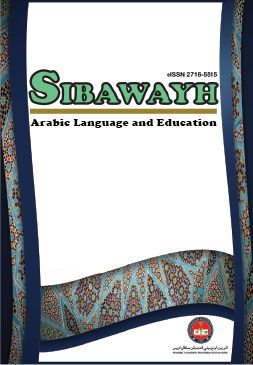الوظيفة الجمالية للنحو في تراثنا النقدي العربي القديم عبد القاهر الجرحاني نموذجاً
The esthetic function of grammar in our ancient Arab critisism heritage- Abdul-Qaher Al-Jorjani as a model
DOI:
https://doi.org/10.37134/sibawayh.vol1.2.9.2020Keywords:
Systems, meaning of grammar, differences and faces, functions of words, styleAbstract
In his books “DalaelI”jaz” and “Asraralbalara”, Abdul-Qaher Al-Jorjani represents "the secrets of rhetoric" and "the signs of miracles" in our Arab heritage, the most mature attempts in analyzing literary style or text are based on his understanding of the function of grammar in the speech system and the production of the significance. He was guided by the fact that any literary statement is language-based but has identifiable characteristics, which he enters within the limits of art, which implicitly distinguishes between language in the sense of a well-established grammar system in the consciousness of the community and speech in the sense of the actual realization of these laws in a particular speech. The poet's lexical work - for example - with the language similar to that of the manufacturer's relation with its raw material, the latter does not start the subject of words or its meaning, but reforms the humble words on them in new relationships, producing a form that affects its significance, and who is given its eloquent communication. The poet is not only standing at this point, but her own example extends to the semantics that Abdul Qaher calls “ meanings of the grammar” .The research seeks to reveal the grammar theory of Abdul Qaher Al-jorjani, which came in introduction, three chapters, and conclusion. The first: Abdul Qaher Al-Jorjani and his grammar philosophy. Second: The role of grammar in the production of significance.The third: Creative grammar relationships.
Downloads
References
Tammam Hassan, Arabic means and building, House of Culture, Casablanca, Morocco.2005
Hamadi Samoud, the rhetorical thinker of the Arabs, founded it and developed it into the 6th century, the official printing press of the Tunisian Republic in 1981.
Sha'aa al-Sayed, Stylistic Trend in Literary Criticism, Cairo Arab Thought House.2015
Abdessalam Al-Masdi, Stylisti and Stylistic, Arab Book House, 2nd Edition, 1982.
Abdul Qahir Al-Jarjani, Signs of Miracles in The Science of Meaning, Sheikh Mohammed Rashid Reda's Realization, First Edition 1409 Ah/1988, Beirut Scientific Books House.
Mohammed Abdel Mutallab, Issues of Modernity by Abdul Qahir Al-Jarjani, Library of Lebanon Publishers, Egyptian International Publishing Company, First Edition, 1995.
Mohammed Zaki Al-Ashmawi, Issues of Literary Criticism between The Old and The New, The Arab Renaissance House for Printing and Publishing in 1979.
Mustafa Nasif, the language between rhetoric and stylisticism, literary cultural club in Jeddah, Saudi Arabia, 1989.
Mustafa Nassif, Arab Critic, Towards a Second Theory, National Council for Culture, Arts and Literature, Kuwait, March 2000.





